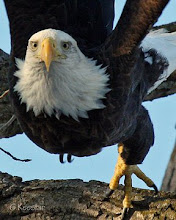share a little eagle fix from the Quad Cities area.
Here is a graph From US Fish and Wildlife Service I want to share with you first.

I have snagged a smaller are from this and pointed to my approximate location
on the graph.

This is where I enjoyed watching so many eagles on Dec 27, about 10 minutes
from my home.
Here is a link to a slideshow I made from yesterdays trip to the River.
You Tube also has a video with some of the sites and sounds here.
Winter is a difficult time for our feathered friends however:
During the winter, numerous eagles from northern states and Canada migrate south to find food. The birds begin arriving in Iowa during September and become more numerous through January, depending on the harshness of the winter. By the mid-1980s approximately 1,500 eagles total wintered in Missouri, Illinois, and Iowa. By 1996, that number has escalated to nearly 5,700 wintering eagles, more than one-third of all bald eagles counted in the lower 48 states during winter. Usually, only 200 to 300 eagles winter in Minnesota and Wisconsin.
The highest concentration of eagles in the Midwest is along the Mississippi River. Approximately 2,500 to 4,000 bald eagles winter along the Mississippi between Minneapolis and 50 miles south of St. Louis. The Mississippi River is a popular wintering area for bald eagles because of abundant food and open water, particularly at locks and dams and power plants that keep the river from freezing. This provides the eagles with an area to hunt their primary food source--fish. Gizzard shad and other fish often are stunned as they pass through the gates of the dam. This creates an easy-to-catch source of food for eagles. At Keokuk, where these conditions exist, 100 to 400 bald eagles may winter in the area.
In addition to food, eagles need places to roost during the night and perch during the day. Bald eagles generally roost together in large mature trees surrounded by a buffer of smaller trees. Roosts are chosen by the eagles to provide protection from the weather and avoid disturbances. Roosts are also generally close to a source of food. Daytime perches are usually within 60 yards of the water’s edge. Large cottonwoods tend to be used most frequently, although the eagles will choose smaller trees that are closer to the water. On mild days eagles may be seen standing on the ice.
Eagle Etiquette
During the winter, bald eagles are under pressure to consume enough food and expend as little energy as possible in order to maintain body heat. If fishermen, bird watchers, or boaters get too close to the eagles, the birds will waste valuable energy flying away. It exposes them to undue stress and could cause abandonment of a site. To avoid disturbing eagles, do not get any closer than 400 yards from a perched eagle. If vegetation obscures the eagle’s view of you, still avoid getting closer than 100 yards. When possible, stay in your vehicle, use a blind, or stand behind stationary objects when viewing eagles. Stay on the opposite side of the river or lake to allow them a peaceful refuge. Since over 70 percent of the eagle’s feeding occurs during the early morning, avoid visiting areas that eagles rely on for food before 9 a.m. That will help to allow the eagle enough time to adequately feed before human activity disrupts their forage. For a large bird with no natural predators, the mortality or death rate of the bald eagle is quite high. The chances of a juvenile bald eagle surviving its first year of life today are less than 50%. After that first year, the bald eagle stands a much better chance of living to its full lifespan, which is anywhere from 30-40 years in the wild. The mortality rate of the bald eagle falls to about 25% after the first year of life. The hazards of the wild are clear when one considers that a bald eagle raised in captivity may add an additional ten years to its lifetimeing.
Mortality is highest for eagles in their first year of life, especially their first six months. The first winter is crucial
SO IF YOU ARE GOING EAGLE VIEWING ANYWHERE PLEASE BE CONSIDERATE OF THESE BIRDS, AND ESPECIALLY AWARE OF THE YOUNG YOU SEE THIS WINTER. gIVE THEM ALL THE CHANCE YOU KNOW HOW TO LEARN TO SURVIVE AND FLY FREE!!!
Above info and stats gathered from various online info. I am not an eagle expert just another eagle lover sharing the info I have with you.
What is happening around the EagleCam web?
 |


















